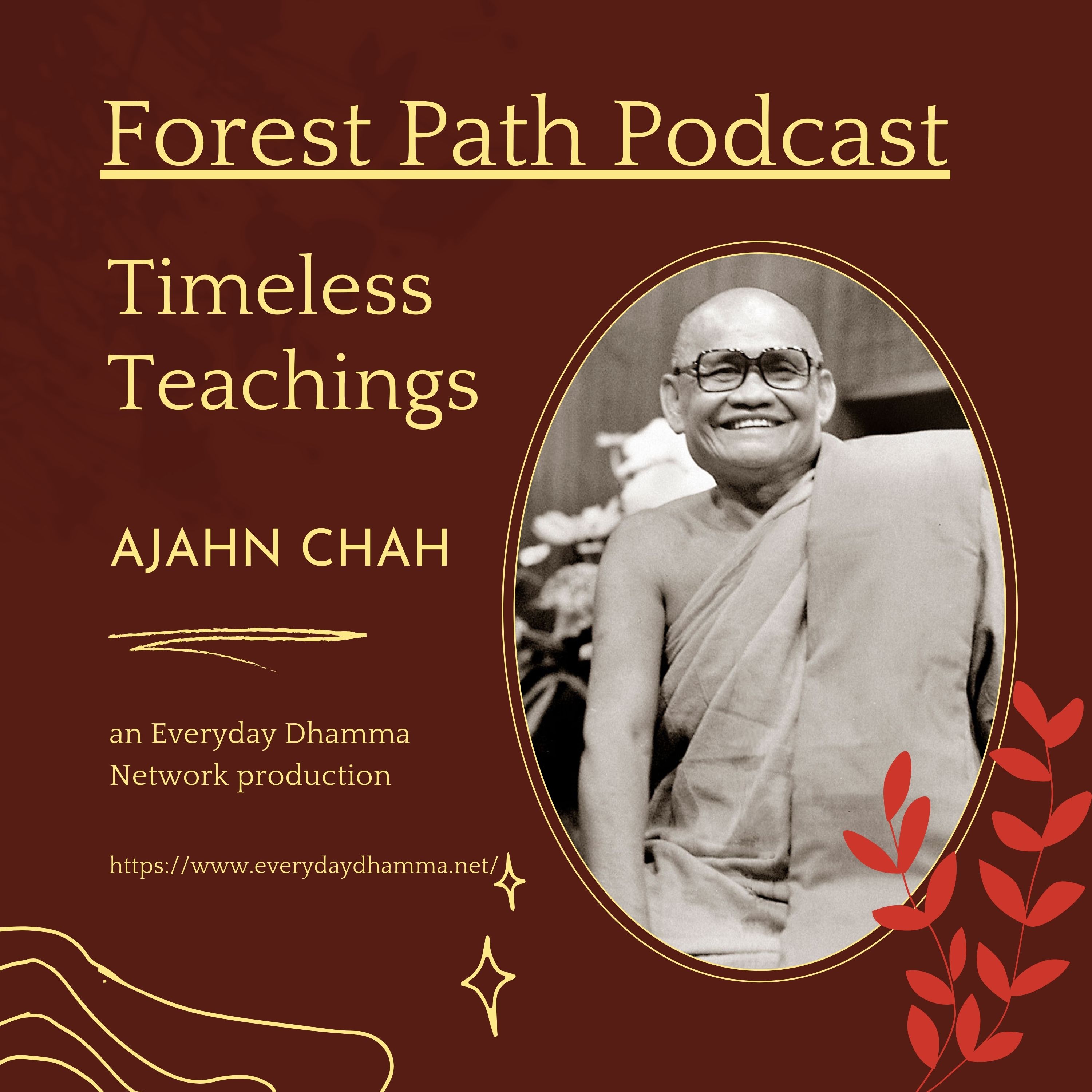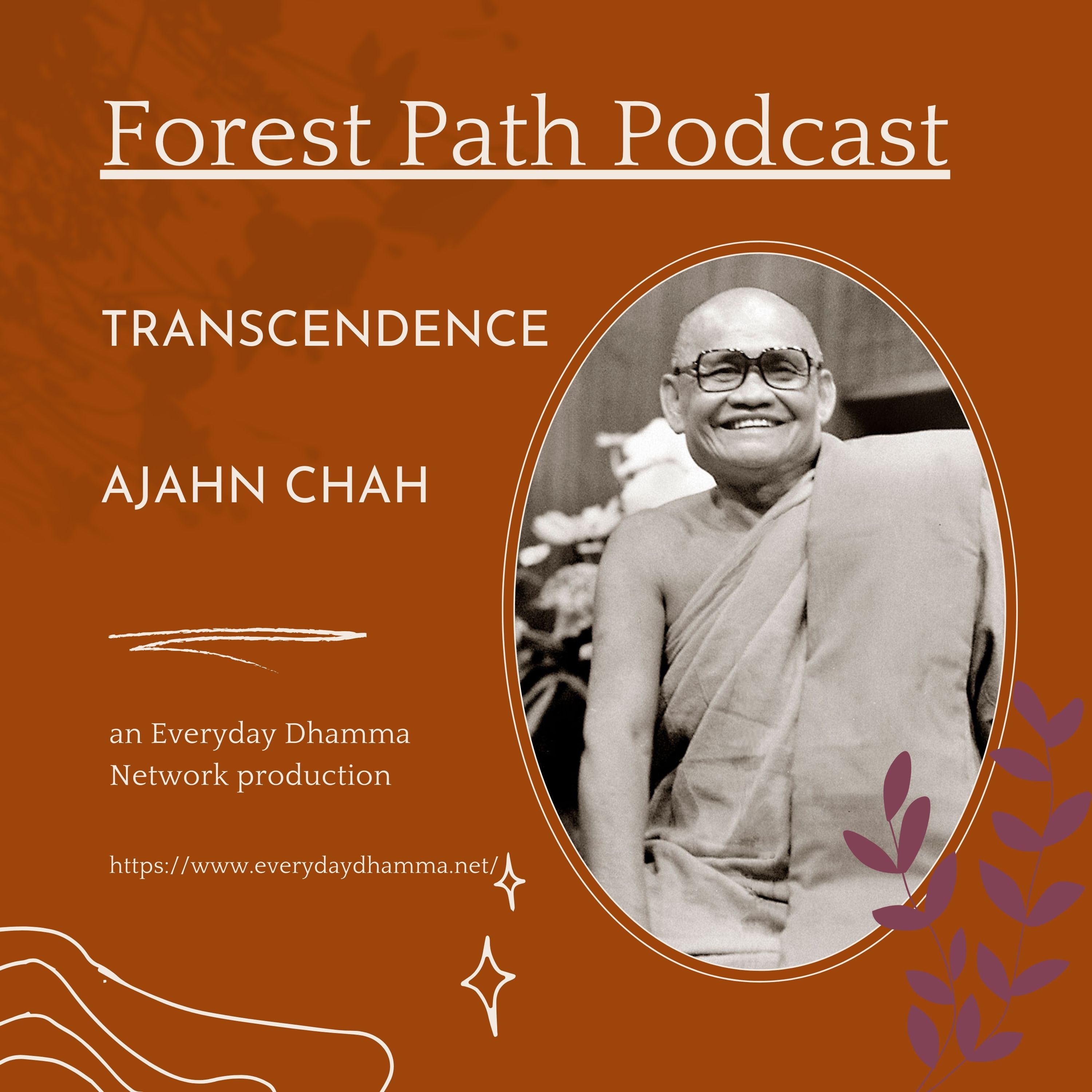Episode Transcript
KAMMAṬṬHĀNA
The term KAMMAṬṬHĀNA means ‘the basis of work’. The work in this place is important and differs from the work that is normally understood by the world. It means the work of uprooting existence, defilement, craving and ignorance1 out of the Heart. To be far away from dukkha (suffering), namely birth, decay, disease, and death, which is the bridge that connects the cycle of rebirth (vaṭṭa), which all worldly beings find difficult to go beyond. The result from this work, even for those who have not yet arrived at the final destination, is happiness both in the present and in future lives. Therefore, a monk (bhikkhu) who is interested in practising this kind of Dhamma2 is known as a ‘kammaṭṭhāna bhikkhu,’ an honorary title given sincerely by fellow Buddhists to those who are interested in this kind of work.
The kammaṭṭhānas that are taught by the preceptor (upajjhāya) at the time of going forth consist of five objects and have been necessary dhammas3 since the Lord Buddha’s time. They are: Kesa - hair of the head; Loma - hair of the body; Nakhā - nails; Dantā - teeth; and Taco - skin; given in both forward(anuloma) and reverse (patiloma) order. One who has gone forth should use these as objects of investigation. He should develop by repeatedly investigating them, again and again, until expertise and a thorough understanding of one or all five objects is acquired. These five objects are important parts of the bodies of all men and women.
However, the kammaṭṭhānas, the ārammaṇa (focusing objects) of the mind, are many. Forty such objects are listed in the books, and for those interested in any of these objects they can easily be consulted. The main point in listing all these different kinds of kammaṭṭhāna is to allow those who are interested in the practice to choose the one(s) that suit their character, since each character differs. This is similar to diseases: they are of many kinds and so likewise are the medicines to suit them.
The way of practice is to take this object and mentally recite, by parikamma-bhāvanā (preparatory meditation), in any bodily posture that is suitable or appropriate. For example, repeating, “kesa... kesa... kesa... kesa...”; or “loma...loma... loma...”; or, simply, “hair... hair... hair...” having mindfulness controlling constantly without letting the Heart wander to other objects. One should maintain the awareness with the particular dhamma object that is being recited without changing that dhamma object too often, for this is the habit of unearnestness. One should try to practise with the same object until either truly experiencing the results or truly knowing that that object does not suit one’s character, before changing to a new object.
The one who knows truly that the object suits his character should use that dhamma as the heart’s anchor and continue relentlessly practising, until successively experiencing the results and rising progressively up to the level of Dhamma where the dhamma object should be changed due to necessity. The practitioner must know this for himself. The results from practising with these or the other kinds of dhamma that suit one’s character are a successive happiness and calm within the Heart. For one who has had no previous experience, the calmness will begin from a low level at first, just a moment of calm, then calm for a moderate duration, and finally for as long as one wishes. That is: one can set up the duration of rest before withdrawing from that state. The calmness also differs in its subtlety.
When the mind (citta) is calm, it is possible to release those disturbing objects. All that remains is ‘knowingness’ and brightness – which are the innate qualities of the Heart – and the happiness that arises out of each respective level of calmness of Heart. There is no duality during that time because the citta is without any object (ārammaṇa). It is all alone by itself. And even if there is within it a subtle kind of defilement (kilesa), it is not manifested. It is comparable to still and clear water without any dust particles. If there are any solid particles, they all settle to the bottom, leaving the water clear and suitable for drinking or other uses.
The longer the Heart is without any ārammaṇa, peacefully alone by itself, the more happiness and marvel there will be, showing how important and worthwhile the Heart really is. Both the marvel and importance will never be forgotten. The nature of the Heart is mysterious and marvellous. When it is made clean, even for just an instant, it immediately shows its marvel. If this state of mind (citta) is allowed to deteriorate due to negligence in not maintaining or developing further in the practice, it can be a great loss and disappointment, caused by the longing for that marvellous experience. It is probably for this reason that during the Lord Buddha’s time, there were cases of some disciples (Sāvakas) whose Hearts progressed and deteriorated six times, causing great disappointment due to the longing for what had been lost. But, finally, they managed to attain and become Arahants (fully enlightened beings). This is due to exertion and diligent effort, which are the bridge that connects and makes possible the attainment of the Amata (undying) Dhamma: the land of bliss which has the kammaṭṭhāna as the means thereto.
All of the countless Buddhas and Arahants attained to Enlight- enment by the various kinds of kammaṭṭhāna, with the five kammaṭṭhāna as the example. There was not a single one of them that realised Dhamma without a kammaṭṭhāna.
It can correctly be said that the kammaṭṭhānas are the wombs of the Exalted Ones (Ariyas). They all depended on the kammaṭṭhāna as the cleansing agent: as the device for their total eradication and uprooting of all the various kinds of views and ‘becomings’ (bhava) – which are the basic constituents of the citta that still falls under the influence of rebirth (vaṭṭa) – before they could transform themselves from a puthujjana (worldling) to an Ariya (a noble one), making their Hearts pure. Therefore, all the Buddhas uphold the kammaṭṭhāna as an important and necessary dhamma and praise it within the circle of the religion (Sāsana).
Even our Samaṇa Gotama4 upheld the kammaṭṭhāna as a fixed example and a tradition to be followed. His attainment to Buddhahood was due to the forty kammaṭṭhānas beginning with mindfulness of the breath (ānāpānasati). This is His teaching for his followers right up to the present. For this is the bridge that connects worldlings to Nibbāna for as long as it is within the ability of worldlings to do so.
For these reasons, the term ‘kammaṭṭhāna’ has always been a special dhamma within the circle of the Sāsana and will always be so. The follower of the Buddha’s Religion who has not yet cultivated and practised the way of kammaṭṭhāna, yet knows something of the mystery hidden within himself (both that which is good and bad), should not think that he is knowledgeable or intelligent. Even if one can remember correctly from the scriptures (Tipiṭaka), it is only an account of good and bad things and the nature that is within oneself. It has not yet been sorted out in practice: having the kammaṭṭhāna asa guide to lead one to the Truth in accordance with the wishes of the Lord Buddha who taught the Dhamma to the world.
These forty kammaṭṭhāna objects are really the essence of the teachings (Tipiṭaka): the means for the destruction of lives and becomings; the device for the total annihilation of the wheel (cakka) that turns worldly beings around the cycle of births and deaths. Any mode of practice that is not supported by at least one of these dhammas will certainly not be for the destruction of the defilements (kilesas) and suffering (dukkha). But the practice that has these dhammas as support will surely be for the destruction of this heap of dukkha.
For this reason, one who practises for peace and happiness – for the penetrative understanding of all the Dhamma – must depend on the kammaṭṭhāna dhammas as the life-line: as the basis of practice all the way from the lowest to the highest level of Dhamma, which is Nibbāna and Vimutti. Regardless of whatever method of doing good one is practising, when it comes to the crux, to the essential – that is, when one is stepping into the different levels of Truth (Dhamma) and Mind (citta) – one must turn to one of these dhammas as one’s means for safely passing through each obstacle. This is because these dhammas are the means for the arising of all true insights (Sacca-Dhamma), having Enlightenment (Magga- Phala-Nibbāna, literally “Path-Fruit-Extinguishment”) as the summit. All of these dhammas are contained within the circle of the Buddha’s Dispensation (Sāsana) – the Buddha of each era teaching them by the very same pattern – and they are thus successively transmitted.
Those who are still doubtful of the Buddhas who taught the Dhamma in the various eras up to our present Lord Buddha should practise and investigate according to the teaching of the kammaṭṭhāna-dhammas. Once one has truly proven with insight (paññā) and has experienced the Lord Buddha’s intended results, one will definitely know – through true knowledge and experience based on one’s practice – that the Teacher (Sāsadā) and Dhamma are not different but are one and the same thing. This is in accordance with the essence of Dhamma, which, briefly summarized, is this: "Whoever sees the Dhamma, sees the Buddha". This verse announces all the Buddhas to us very clearly, and that the Buddha is with the Dhamma at all times. It does not depend on time and place. Although each Buddha has entered into Parinibbāna5 following the understanding of sammuti (conventional reality), the Truth of the Buddha is nothing other than this very Dhamma.
Those who have seen clearly and penetratively the Dhamma within the Heart have no doubt in the Buddha, or as to where the Buddha exists. The world, however, understands that once they have entered Nibbāna, they all quietly disappear; that there is no more Teacher to compassionately teach. But the truth is that the Dhamma that has been taught really is the Teacher. If one is interested in having a teacher within their heart, one can have one at any time, just as in the time when the Lord Buddha was still alive. The important thing is one’s earnestness in respecting and believing in Dhamma which is the Buddha’s representative. Even if the Lord Buddha were still alive, if one simply has no interest it would be impossible to be helped. One will remain the helpless type. No improvement could be made.
In order to prevent any hardship that might later arise, and to ensure security both in the present and in the future, one should practise and cultivate oneself with the Dhamma which was given by the Lord Buddha as his representative and inheritance. The results will be the same in all aspects, just like when the Lord Buddha was still living. Nothing has changed. One will then have Dhamma as the Teacher in the Heart at all times.




